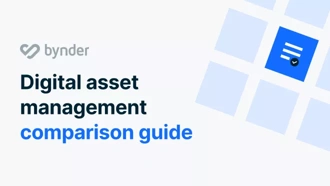Building your marketing resource management business case
Where to start?
When building a business case for marketing resource management, it’s important to define the challenges your marketing department faces—whether you’re struggling to manage your ever-growing number of campaigns; you need more transparency in your budget allocations or you need to prove the value of your marketing investments. Later we’ll go into more detail about how an MRM solution improves marketing efficiency, but for now, here’s a general overview of how MRM solves the above challenges.
- Marketing resource management is a one-stop-shop for managing marketing activities
MRM systems provide marketeers with a central location to create, organize and manage campaigns. Upload, store and share digital assets, and monitor and control budgets and expenditures. - Marketing resource management streamlines marketing processes
MRM enables global marketing teams to work as one. Thanks to centralized asset libraries and workflow modules, marketeers can share files and collaborate on projects regardless of where they are in the world. - Marketing resource management helps marketeers be more economical
Planning and financial management modules help marketeers monitor spending, allocate resources and measure the ROI of marketing campaigns, as well as increase transparency when it comes to budget allocations.
Improve marketing return on investment
Planning and financial management modules empower marketing departments to improve planning and budgeting processes, and revenue management. This allows marketeers to allocate more resources to successful campaigns and stop underperforming ones.
Improve productivity
Asset workflow modules enable marketeers to streamline the content creation process, improve accountability, and achieve a quicker time to market.
Cut agency costs
With digital asset management, companies can upload, store and manage their marketing materials, reuse existing content and improve brand management.
Reduce waste and improve reuse of marketing content
MRM solutions provide 24/7 access to marketing content, allowing users to order, print, and download assets directly.
Increase return on marketing investment (ROMI)
MRM software helps organizations measure the creation time, cost, and performance of marketing collateral produced by internal departments or external agencies.
Investments and costs
The number of users
Your subscription cost will depend on how many users you have and the type of user. There are three user types, each with different rights and responsibilities:
- Admin: refers to a user who has full access rights within the product
- Regular: refers to a user that has the access permissions of a light user, as well as the rights to upload and edit media and manage guidelines
- Light: refers to a user that can share and download, but has read-only rights to the media. A light user can also view and create media collections
The amount of storage
Storage space can range from 50 GB to unlimited TB. As with the number of users, the more storage you have, the higher the subscription. There are two types of storage:
- Hot Storage: storage used on a daily basis / often
- Cold Storage: storage that you don’t use but want to keep on your platform to be accessed at anytime—considered archive storage
The number of modules
The price will depend on the number of modules you need. As you can imagine, the more modules you require, the higher the cost.
- The Number of Modules: many vendors offer different modules and functionalities depending on a company’s requirements. As a DAM is the foundation of an MRM solution, it is often the most expensive module, especially if it needs to be personalized to your own needs, e.g. add / edit existing functionalities
One-off configuration and setup fees
This is the cost associated with customizing the platform fully and integrating it with your company’s information system. The main factors that drive the cost of your configuration and setup fee are custom theming, import of media, the configuration of taxonomy, and API.
Professional service fees
Once the environment is complete from a technical perspective, your vendor will train the project managers to ensure a successful implementation for all users. This includes support when launching the portal—user invites and imports—and project management and consultation (e.g. taxonomy setup, etc.).
Training fees
After the solution has been implemented, most vendors provide training to help with the onboarding process. This includes personal demos, tutorial videos, and in-house implementation training.
MRM/DAM quote
For a no obligation MRM/digital asset management quote, click here. Our experts will get back to you within the same business day.



